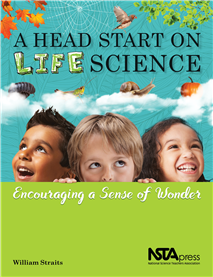New Book Helps Teachers of Young Children Discover the Wonders of Science Exploration
By Carole Hayward
Posted on 2018-03-05
Curiosity, joy, and wonder. Our youngest students possess an over-abundance of these qualities, and when their teachers successfully tap into them, they help nurture a lifelong love of science.
 But finding resources to help make science education relatable and engaging for three- to seven-year-olds can be challenging. That’s why educators will enthusiastically welcome William Straits’ wonderful new book A Head Start on Life Science: Encouraging a Sense of Wonder, which offers 24 inquiry-based lessons that encourage children to make scientific discoveries on their own. We dare you to resist the urge to explore a book whose cover features three wide-eyed, smiling youngsters enthusiastically observing the natural world around them.
But finding resources to help make science education relatable and engaging for three- to seven-year-olds can be challenging. That’s why educators will enthusiastically welcome William Straits’ wonderful new book A Head Start on Life Science: Encouraging a Sense of Wonder, which offers 24 inquiry-based lessons that encourage children to make scientific discoveries on their own. We dare you to resist the urge to explore a book whose cover features three wide-eyed, smiling youngsters enthusiastically observing the natural world around them.
Straits directs the National Center for Science in Early Childhood where he works with teachers who “lovingly and tirelessly” dedicate their careers to helping children expand their joyful “sense of wonder” about the natural world. In writing this book, he collaborated with an extensive list of science and early childhood educators. Photos that capture some of the engaging lessons in action were taken at the Harry and Grace Steele Children’s Center at Orange Coast College and are featured throughout the book.
“We believe that a sense of wonder is part of all children’s experience and that children are intrinsically motivated to explore the natural world,” Strait says. “Therefore, it is important that all children have access to culturally relevant science experiences that are of value in learners’ everyday worlds. Our goal is not for children to acquire ‘facts,’ but to be active explorers, reveling in the process of discovering more about the natural world around them.”
Each lesson is aligned with high-quality early childhood science education and inspired by the learning cycle’s three-part teaching that first orients children toward the topic to be investigated, then gives them a chance to explore and develop an understanding of the concept; and finally offers students a situation where they can apply their new understandings.
This book is a follow up to NSTA’s popular A Head Start on Science and allows teachers to generate a greater interest among their students in life science by: offering a diverse range of inquiry-based and engaging lessons on animals, plants, and nature walks; connecting to a range of other subjects such as reading, art, writing, dramatic play, and math; and extending learning beyond the classroom with activities—written in both English and Spanish—so that children can continue to explore life sciences with their families via activities that are related to their everyday lives.
Read the free sample chapter, “Science for Young Children”, to understand the components of a high quality ECSE and what constitutes developmentally appropriate science; get a lesson overview, learn how to plan for a lesson, and more.
This book is also available as an e-book.
Don’t miss out on this opportunity to make science accessible to your youngest students. There are jumping crickets, earthworms, and snails to observe; plants to smell, compare, and measure; weeds to investigate and map where they grow, outdoor scavenger hunts to plan, and so much more.
Follow NSTA
Disclaimer: The views expressed in this blog post are those of the author(s) and do not necessarily reflect the official position of the National Science Teaching Association (NSTA).

